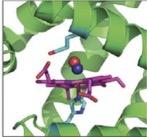
Lost in all the talk about toxicity, endocrine disruption, and the like, is one fundamental property of chemicals, drugs, enzymes, and receptors, that people do not fully appreciate: Binding affinity— the tightness that ligands (chemicals, drugs) stick to their targets (enzymes, receptors).
Perhaps the best example of this property is carbon monoxide (CO). The reason that the colorless, odorless gas is so dangerous is that its binding affinity to hemoglobin, the protein that carries oxygen in the blood throughout the body, is so strong (about 1,000-times that of oxygen) that it easily displaces oxygen from hemoglobin, which causes asphyxiation very quickly. In other words, oxygen doesn't have a chance when CO is around.
(For a more detailed look at how this works, see: Why Carbon Monoxide is So Dangerous.)
But, Ivan Azarov and colleagues at the University of Pittsburgh School of Medicine writing in Science and Translational Medicine took advantage of just this when looking for an antidote for CO poisoning (there isn't one). They could have one important discovery on their hands.
The group examined a modified hemoglobin-like protein found in the brain called neuroglobin (Ngb), whose function is to regulates oxygen. It turns out that Ngb has a number of naturally occurring mutants. During purification of the protein, Azarov's group isolated one of these called Ngb H64Q and studied its CO binding properties. They found that CO binds 500-times more strongly to modified H64Q than it does to hemoglobin. Consequently, H64Q displaced CO from red blood cells 1200-times faster than regular air, which is consistent with its strong binding affinity. So, at least in theory, an injection of H64Q should suck the CO out of hemoglobin in red blood cells, and allow oxygen to take its rightful place.
Azarov's group has gone past theory. They were able to protect mice already exposed to lethal levels of CO by giving them injections. Within minutes, measures of CO poisoning (survival, heart rate, blood pressure) were back to normal. The CO was detected in the urine, bound to the neuroglobin, which is what you would expect.
I have often talked about the predictive value of animal models for human conditions. They are highly variable, depending on both the animal and the disease. This one looks pretty good. Let's hope so. Plenty of people will need it every year.
Source: Ivan Azarov et al. "Five-coordinate H64Q neuroglobin as a ligand-trap antidote for carbon monoxide poisoning." Science Translational Medicine 8 (368): 368ra173. Published: 7-Dec-2016. DOI: 10.1126/scitranslmed.aah6571



